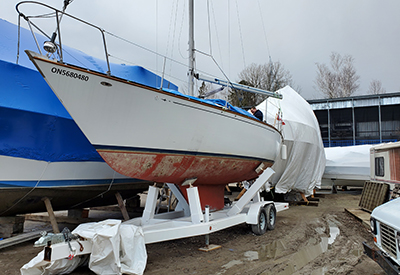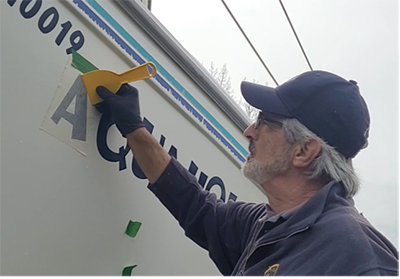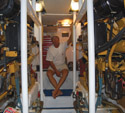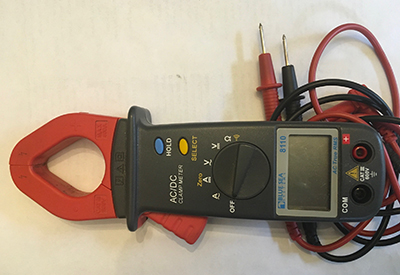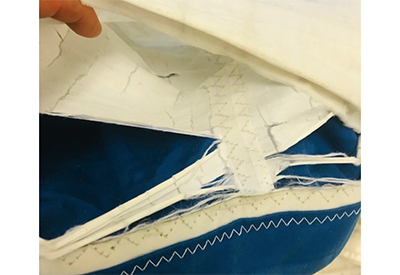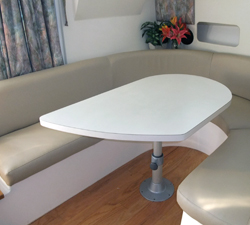Extend Your Season With A Non-Electric Heating System
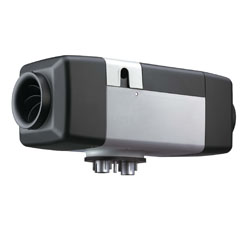
We thought this was a good time to remind our readers that there are a number of highly effective heating systems that you could have onboard to extend your cruising season, but without needing shore power, or running a generator.
I know it's tough to beat the comfort and efficiency of a reverse cycle system that provides heat, dehumidification and air conditioning for year-round comfort, but almost all of these systems need either shore power, or a big load of 110 V AC from a generator system. When you're away from shore, traveling from A to B, it's nice to stay warm, dry and comfortable without needing to run your generator.
That's even more significant on a sailboat where the generator noise is usually much more noticeable than it is on a power boat where the engines are running anyway. Of course, on the hook, silence is one of the great rewards so the less noise you get from the heating system the better.
Onboard heating systems are available for boats from the mid-20 foot range to superyacht sizes; some smaller systems start under $600. Some can make use of a handful of charcoal briquettes to deliver heat, some use kerosene and by far the most popular choice is diesel fuel. Diesel is especially attractive because you probably have a big tank full of diesel onboard anyway and there are systems that can do great job of keeping your boat warm, dry and comfortable using less than two gallons a day.
Part of the efficiency is because these stoves convert diesel fuel directly into heat with no "middle man" generator or other equipment involved. Here are a few of the heating choices on the market today that can help you extend your cruising season.
Whether we're talking about a power boat or sailboat, no matter how big the boat, space is always at a premium. Two companies that produce diesel heater systems that can be installed behind a bulkhead or in a locker out of sight and out of mind are products from Webasto and Espar.
The diesel fuel Webasto and Espar marine air heating systems are cost-effective and their high-performance warm air circulation systems quickly brings the boat interior up to the desired temperature. Fully independent from the engine, these marine air heating systems are extremely quiet.
The Webasto Marine Air Heating System Air Top 2000 ST is especially compact and the smallest Webasto air heater in their extensive line is economical and features convincing heat output.
One of the most delightful choices would be a stove or bulkhead heater from Dickinson Marine in British Columbia. They offer a range of diesel heaters that use 12V fan blowers with 24V or 32V models available. I like the little NEWSF heater that burns a handful of briquettes, a few bits of wood or even coal and it can make up to 8000 BTU on high setting yet it costs just $538. The warm glow and the drying effect on a damp fall day are so pleasant that you will look forward to fall just to enjoy it.
A company called International Thermal Research sells a selection of heating systems; some can incorporate the use of engine heat to supplement diesel fuel heat and as well as cabin heating, the Hurricane SCH-25 system can also deliver hot water. Very useful!
Perhaps one of the most innovative choices in the market is from a Finnish company called Wallas. While Wallas builds a range of products including heaters that operate on either diesel fuel or kerosene, the one that catches our eye is the diesel-fueled Wallas cooktop for your galley. What makes this so innovative is that it can be operated in the closed position with a 12V blower that blows the heat from the stove top out into the cabin.
Wallas is the only manufacturer we know of to offer combination cooktop heater units. The burning process in Wallas products is based on laminar combustion and the process is virtually silent, requiring no exhaust sound attenuation. In addition, the combustion process is also very clean.
Whether you find yourself hauling the boat and ending the season now, or you are courageously sailing on with numb hands and chattering teeth, think about what you would gain by having a non-electric onboard heating system. Perhaps your favorite dealer or service shop can still install one for this year but if it's too late now, don't forget that you will want it again next April!
Installing Your Own Heating System
Many of the manufacturers offer their products in a kit form that is usually quite complete and includes in-depth instructions on the procedures required for a proper, safe installation. Typically, these kits come with the heater and enough material to complete the install by a person who has what we would describe as advanced mechanical, electrical, and carpentry skills. After all, you are cutting into your own boat!

Depending on the kit, the heater and fuel pump, heater mount, exhaust elbow, drip leg, double weave exhaust hose, fibreglass sleeve (for covering exhaust hose), wiring harness, fuel tank pick-up, heater duct vents and Y connectors, exhaust thru hull, digi controller, heater duct hose, numerous hose clamps and fasteners are all included.

Normally on a sailboat, the heaters are installed in a cockpit locker and exhaust on the stern or high up the side at the stern. Some installations might require wood stringers to be fibreglassed to the hull for a mount to secure the heater.

Barry Lamont recommends that you install the fibreglass sleeve (in kit) over the exhaust hose, then use a piece of heater duct over this because the exhaust gasses are hot and could melt a fender or burn flesh if you make contact.
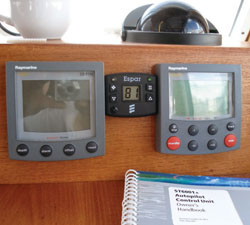
The thermostat control looks like a regular part of the helm equipment but Barry cautions to mount it out of the sun and down low enough to eliminate the effect of rising heat.
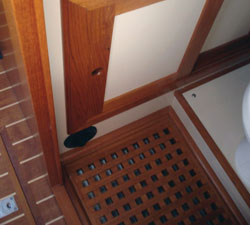
When you do the install, plan a way to get a vent into the head area at a level where the heat can rise and move the heat through the space.
Barry Lamont at Sea Tech Marine in Ontario has installed many Espar heating systems. He pointed out that Espar and some other companies offer an online guide you can use when sizing a new heater. As an example, Espar offers systems from 6000 to 41000 BTU. List prices on three of their marine kits range from $3,000 to $4,000!
By Andy Adams

